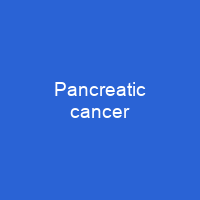Understanding Pancreatic Cancer: A Silent Killer
Pancreatic cancer is a formidable adversary in the realm of medical conditions, often referred to as the ‘silent killer’ due to its insidious nature and lack of early symptoms. Imagine a stealthy intruder that quietly infiltrates your body, multiplying out of control before you even realize it’s there. This is precisely what pancreatic adenocarcinoma does—accounting for 90% of all cases.
Signs and Symptoms: The Invisible Enemy
The signs and symptoms of pancreatic cancer can be as elusive as a ghost, making early detection incredibly challenging. Yellow skin (jaundice), abdominal or back pain, unexplained weight loss, light-colored stools, dark urine, and loss of appetite are some of the tell-tale signs that might appear when the disease has already spread. But here’s the catch: in its early stages, pancreatic cancer often doesn’t show any symptoms at all! By the time you notice something is wrong, it may be too late.
Risk Factors and Prevention
So, what puts someone at risk? Smoking, obesity, diabetes, and certain rare genetic conditions are among the factors that can increase your chances of developing pancreatic cancer. But there’s hope! Maintaining a healthy weight, increasing fruit and whole grain consumption, and reducing red meat intake can help lower your risk. Screening is not recommended for the general population but might be beneficial for those with high-risk genetics.
Diagnosis: A Journey Through Imaging
When symptoms do appear, a combination of medical imaging techniques like CT scans, endoscopic ultrasound, and MRI are used to confirm the diagnosis. Blood tests can also provide valuable information, particularly the CA19-9 tumor marker. Biopsy by fine needle aspiration may be necessary when there’s uncertainty about the diagnosis.
Treatment: A Multifaceted Approach
Once diagnosed, treatment options vary widely depending on the stage of the cancer. Surgery can cure pancreatic adenocarcinoma but is often used to improve quality of life in cases where a complete removal isn’t possible. Chemotherapy and radiotherapy are also common, with regimens like FOLFIRINOX showing promising results. Palliative care focuses on managing symptoms and improving quality of life for those diagnosed at an advanced stage.
Prognosis: A Grim Reality
The prognosis for pancreatic adenocarcinoma is generally poor, with only about 20% five-year survival rates for early-stage cases. However, the outlook for pancreatic neuroendocrine tumors (PanNETs) is much better, with a five-year survival rate of around 65%. The distribution of deaths from pancreatic cancer globally stands at an alarming 411,600 in 2015.
Evolution and Research
The journey to understanding and treating pancreatic cancer has been long and arduous. From the first partial pancreaticoduodenectomy in 1898 to modern keyhole surgery techniques, significant advancements have been made. Early-stage research continues to focus on genetics, early detection, treatment strategies, and targeted therapies. Diabetes as an early sign of the disease, screening strategies, and new drugs like FOLFIRINOX are all areas of active investigation.

As we continue to unravel the mysteries of pancreatic cancer, one thing is clear: early detection and prevention are key. By staying informed and making lifestyle choices that support your health, you can significantly reduce your risk. Remember, knowledge is power in this battle against a silent killer.
Conclusion: Understanding pancreatic cancer involves recognizing its stealthy nature, understanding the risks, and embracing proactive measures for prevention and early detection. With ongoing research and advancements in treatment, hope remains for better outcomes and improved quality of life for those affected by this formidable disease.
You want to know more about Pancreatic cancer?
This page is based on the article Pancreatic cancer published in Wikipedia (retrieved on February 19, 2025) and was automatically summarized using artificial intelligence.




